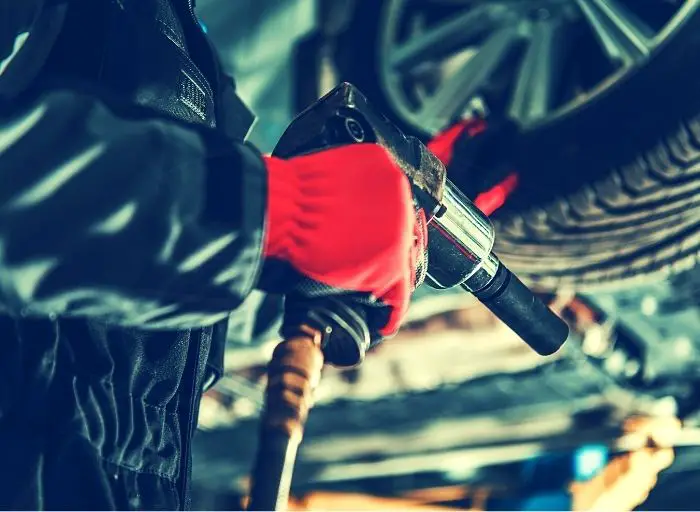
An alignment is a frequent element of vehicle maintenance, and it’s common to notice a few differences in your vehicle’s ride and performance following one. Does alignment affect ride height?
Because the tire position and pressure have been rectified, an alignment will usually result in only minor modifications in your ride height. If a mechanic lifted your vehicle, you may also feel that the springs are a little higher. Large variations in your vehicle’s ride height, on the other hand, should not be due to alignment.
Table of Contents
What Is the Car Alignment?
Car alignment, also known as wheel alignment, refers to the process of adjusting the angles of the wheels so that they are parallel to each other and perpendicular to the ground. Proper alignment ensures that the tires make contact with the road at the optimal angle, reducing wear and tear on the tires, improving gas mileage, and enhancing the overall handling and safety of the vehicle. T
here are three main alignment angles that are adjusted during the process: camber, toe, and caster. Camber refers to the angle of the wheels in relation to the vertical axis, toe refers to the angle of the wheels in relation to the longitudinal axis of the vehicle, and caster refers to the angle of the steering axis in relation to the vertical axis. A qualified mechanic can perform an alignment check and adjustment as needed.
What is Ride Height?
Ride height refers to the distance between the ground and the lowest part of a vehicle’s chassis or body, typically measured at the front and rear of the vehicle. It is an important aspect of a vehicle’s suspension system and can affect its handling, performance, and overall appearance.
The ride height can be adjusted by changing the suspension components, such as springs or shocks, or by modifying the body of the vehicle, such as adding a lowering kit or lifting kit.
Lowering the ride height can improve the vehicle’s handling by lowering its center of gravity while raising the ride height can improve its off-road capabilities by providing more ground clearance. However, altering the ride height can also affect the vehicle’s stability, ride comfort, and tire wear, so it should be done carefully and with consideration of the vehicle’s intended use.
When It Comes to Ride Height, How Vital Is It to Consider It?
The clearance space between the road and the bottom of the car is measured in ride height. This height has an impact on the car’s braking and cornering performance, including its center of gravity.
A pre-alignment check is just as critical as the ride height before beginning the wheel alignment process. During this inspection, pay special attention to the status of the tire and the depth of its treads, as well as the tire pressure and the condition of the bushings and suspension components, as these factors might affect the car’s ride height.
Ride height is generally overlooked by experienced persons because it is not essential to measure for every car. However, if assessed beforehand, it can impact the camber, toe, and readings of the angle of inclination of the steering wheel, as well as the caster.
Causes of Uneven Ride Height
Uneven ride height can result in a variety of issues, ranging from poor turning ability to uneven tire and suspension wear. To minimize unwanted damage to your vehicle, it’s critical to get to the source of the problem as soon as possible.
After an alignment, many individuals notice an uneven ride height since the alignment corrects how your automobile performs and makes disparities more visible. It can also help you notice uneven ride height if your wheels’ camber was out of standard before the alignment.
Here are some common causes of uneven ride height:
1. Tire problems
Uneven ride height and fluctuations in ride height might also be caused by your tires.
If you don’t rotate your tires often enough, they’ll create an uneven wear pattern, which will have a significant impact on the performance of your vehicle over time. As other components in your car are stressed, that wear pattern could either affect or play a part in your ride height.
Tires with excessive wear, on the other hand, can cause problems because they won’t work correctly without tread. Excessive tire wear causes a variety of issues, but one of the most common is an uneven or changed ride height.
2. Suspension bottoming
Suspension bottoming is a common source of uneven ride height and a symptom that your suspension system’s springs and other load-bearing elements are worn out.
Suspension bottoming occurs when the total travel distance of your suspension system begins to decrease. It can be influenced by the load in your car, but if that’s the case, you should see an improvement in performance as soon as you clear it.
Of course, if you haul high loads on a frequent basis, your suspension system will wear out considerably faster than if you don’t.
3. Improper camber
This is one source of uneven ride height that an alignment may be able to address. The camber of the wheels, or the little tilt of your tires, is utilized to ensure that the stress of driving is spread equally across your tread.
When that angle is off, it can cause not just wear and tear on the wheels and tires, but it can also result in uneven ride height in extreme circumstances. If this is the cause of the problem, you’ll usually notice side-to-side uneven ride height rather than front-to-back uneven ride height.
How Does Ride Height Affect Alignment?
The ride height of a vehicle can have an impact on its alignment. When a vehicle’s ride height is significantly altered, either by lowering or raising it, the angles of the wheels can change, which can affect the camber, caster, and toe settings.
- Lowering a vehicle can cause the wheels to tilt inward, resulting in increased negative camber, which can cause the tires to wear unevenly on the inside edges.
- Raising a vehicle can cause the wheels to tilt outward, resulting in decreased negative camber, which can cause the tires to wear unevenly on the outside edges.
- Changes in ride height can also affect the toe setting, which is the angle of the wheels in relation to the longitudinal axis of the vehicle. Lowering a vehicle can cause the front wheels to toe out while raising it can cause the front wheels to toe in.
These changes can cause the tires to wear unevenly and can also affect the vehicle’s handling and stability. Therefore, it’s important to have the alignment checked and adjusted after making any significant changes to the ride height of a vehicle.
Common Problems After Car Alignments
While car alignments can improve ride quality and handling, there are some common problems that people may experience after getting an alignment:
- Uneven tire wear: If the alignment is not done properly, it can cause the tires to wear unevenly, which can lead to reduced tire life and potentially unsafe driving conditions.
- Steering wheel vibration: If the wheels are not properly balanced during the alignment process, it can cause steering wheel vibration at certain speeds.
- Pulling or drifting: If the alignment is not done correctly, it can cause the vehicle to pull or drift to one side while driving, which can be dangerous and require further adjustment.
- Crooked steering wheel: If the alignment is not done properly, it can cause the steering wheel to be crooked when driving straight, which can be a sign that further adjustment is needed.
- Suspension issues: While rare, some people may experience suspension issues, such as a bumpy ride or noisy suspension components, after getting an alignment. This can be caused by improper adjustment or damage to the suspension system during the alignment process.

Frequent Asked Questions
Do wheel alignments affect ride?
Yes, wheel alignments can affect ride quality as they ensure that the tires are properly aligned with the suspension and steering systems of the vehicle, which affects how smoothly the car rides and handles.
Do alignments affect car suspension?
Yes, alignments can affect car suspension as they ensure that the wheels are properly aligned with the suspension components, which can affect how well the suspension system functions.
What are the benefits of proper alignment?
Proper alignment can improve handling, increase fuel efficiency, extend tire life, and ensure that the vehicle is safe to drive by reducing the risk of accidents caused by poor handling or uneven tire wear.
How often should I get an alignment?
It is recommended to get an alignment every 12,000 miles or once a year, whichever comes first. However, if you notice any signs of poor alignments, such as uneven tire wear or drifting while driving, you should get an alignment as soon as possible.
What are the signs that my car needs an alignment?
Signs that your car needs an alignment include uneven tire wear, drifting or pulling to one side while driving, a vibrating steering wheel, or a crooked steering wheel when driving straight.
What is the difference between 2-wheel and 4-wheel alignment?
2-wheel alignment only adjusts the front wheels of the vehicle, while 4-wheel alignment adjusts all four wheels. 4-wheel alignment is typically recommended for vehicles with independent rear suspension or four-wheel drive, while 2-wheel alignment is suitable for vehicles with solid rear axles.
How can I adjust my own alignment?
It is not recommended to adjust your own alignment as it requires specialized equipment and expertise. Attempting to adjust your own alignment can result in further damage to your vehicle and compromise your safety on the road.
What factors can affect ride height?
Factors that can affect ride height include the weight of the vehicle, the condition of the suspension system, the size and type of tires, and the amount of cargo or passengers in the vehicle.
What changes can cause low ride height?
Changes that can cause low ride height include worn out suspension components, damage to the suspension system, lowering springs or kits, or overloading the vehicle beyond its recommended weight capacity.
How much does car alignment cost?
The cost of a car alignment can vary depending on the location, the type of vehicle, and the service provider. On average, a standard 2-wheel alignment can cost anywhere from $50 to $100, while a 4-wheel alignment can cost between $100 to $150.
However, prices can vary significantly depending on the make and model of the vehicle, as well as the service provider’s pricing and labor rates. Additionally, any issues with the suspension or steering components that need to be addressed before the alignment can also add to the overall cost.
It’s always a good idea to shop around and compare prices from different service providers before choosing one.
Conclusion
Most mechanics will check your vehicle’s ride height during routine maintenance and again during your next alignment, as the ride height is crucial to getting the alignment right.
If you have regular maintenance for the car, such as alignments, tire rotations, and tire replacements, ride height is unlikely to be an issue.
Further Reading:
- Md. Code Regs. 11.14.02.02 – Steering, Alignment, and Suspension
- Wheel Alignment – New Jersey Division of Consumer Affairs
- How to Fix the Alignment on a Car – wikiHow
- How to Diagnose an Alignment Problem – wikiHow
Hi there! I’m Naomi O’Colman. I’ve got years of experience working at an auto repair shop here in Texas under my belt. On top of that, ever since I was a kid I’ve been passionate about the auto industry. Since I’ve joined the team at automotivegearz.com I’ve been enthusiastically sharing my passion and insights with my readers. I’m dedicated to delivering high quality content and helping you stay up to date with the latest automotive trends and products out there!







